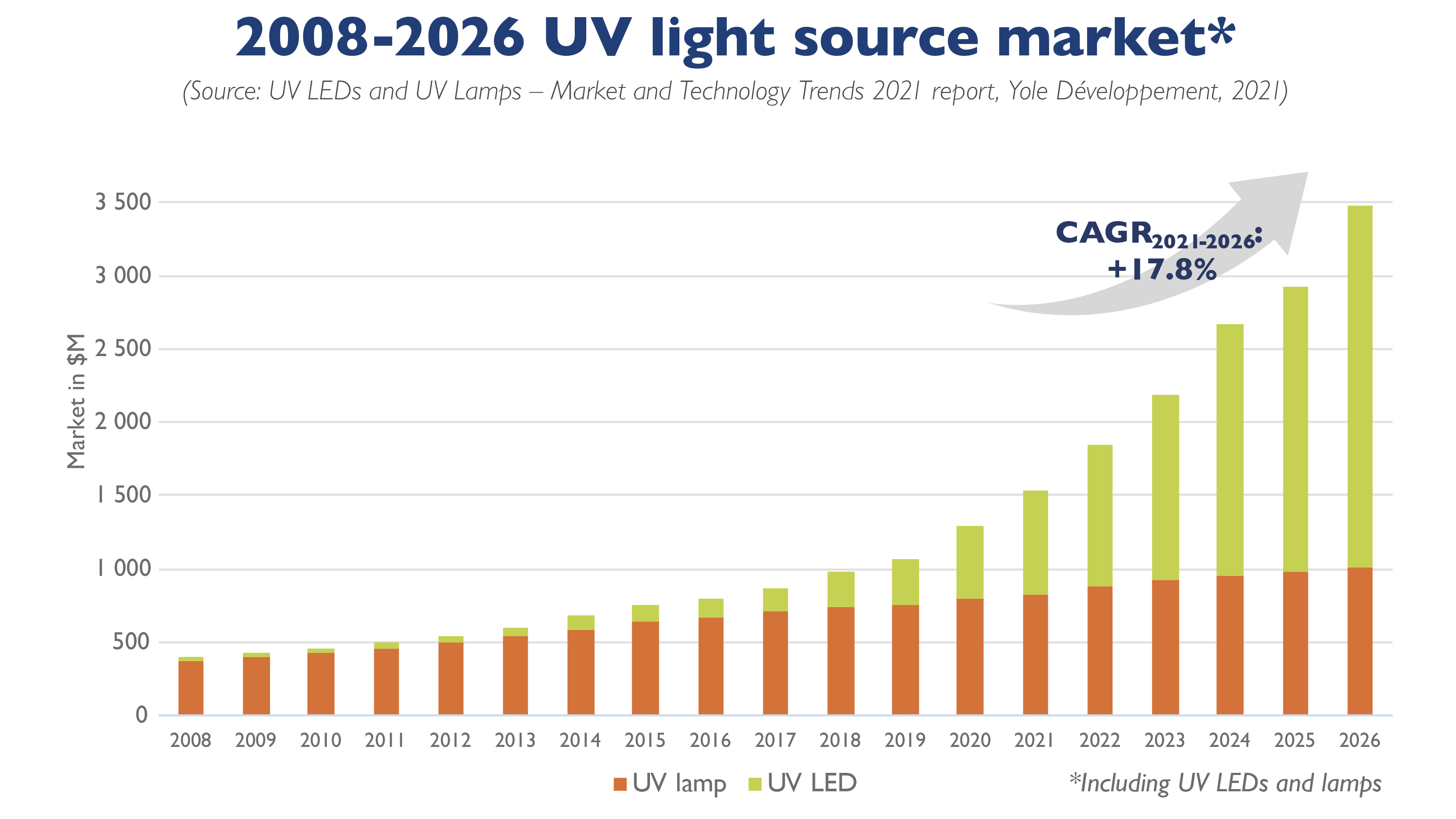UV LEDs post pandemic?

The UV lighting market will double or treble in size in the next five years, says Yole
There will be a 'before' and 'after the COVID-19 pandemic for the UV lighting industry according to Joël Thomé, CEO of Piseo, which has combined its expertise with Yole to look at trends in the UV LED industry.
“The health crisis due to the SARS-CoV-2 virus has generated unprecedented demand for the design and manufacture of disinfection systems using optical UV rays. LED manufacturers have seized this opportunity, and we are currently seeing an explosion in UV-C LED products,” said Thomé.
The UV LEDs and UV Lamps – Market and Technology Trends 2021 report from Yole is a survey of UV light sources and the overall UV LED industry. In parallel, the UV-C LEDs in the Time of COVID-19 - Update November 2021 from Piseo discusses the technical state-of-the-art of UV-C LEDs and possibilities for further development of performance and price. This technical analysis offers a comparative overview of the products of the 27 leading UV-C LED manufacturers.
UV lamps are historic, established, and mature technologies in the UV lighting market. Business before the COVID-19 pandemic was driven mostly by polymer curing with UVA wavelength light and water disinfection with UVC light. On the other hand, UV LED technologies are still emerging. Until recently, business was mostly driven by UVA LEDs. It was only a few years ago that UVC LEDs reached the performance and cost specifications of early adopters and started generating revenue.
According to Pierrick Boulay, senior technology and market analyst, solid-state lighting at Yole: “Both technologies will benefit, but on different timelines. In the very short term, UV lamps might dominate end-systems because they are already established and easy to integrate. However, this proliferation of applications is a catalyst for the UV LED industry that will further push the technology and its performance forward. In the middle-to-long term, several end-systems might further adopt UV LED technology”.
Pandemic demand
The UV lighting market overall was worth around $400 million in 2008. By 2015 UV LEDs alone were worth $100 million. In 2019, the total market reached $1 billion as UV LEDs spread into UV curing and disinfection. The COVID-19 pandemic has then driven demand, increasing total revenues by 30 percent in just one year. In this context, Yole’s analysts expect the UV lighting market to be worth $1.5 billion in 2021 and $3.5 billion in 2026, with a CAGR2021-2026 for this period of 17.8 percent.
Numerous industries and players supply UV lamps and UV LEDs. Signify, Light Sources, Heraeus, and Xylem/Wedeco are the top four UVC lamp players, while Seoul Viosys and NKFG are currently leading the UVC LED industry. There are few overlaps between the two industries. Yole’s analysts expect this to remain the case even though some UVC lamp players, such as Stanley and Osram, are diversifying their activities into the UVC LED field.
Overall, the UVC LED industry is likely to be the most transformed by recent trends. The industry has waited for more than 10 years for this moment to happen. All the players are now ready to grab a piece of this booming market.
UV-C LED-related patents
The number of UV-C LED-related patents filed in the last two years has exploded, thereby illustrating the dynamism of research in this area, states Piseo. In its new UV-C LED report, Piseo offers a particular focus on key patents of four LED manufacturers. This selection highlights the main challenges of the rollout of this technology: intrinsic efficacy and cost. Yole also offers a complementary analysis of the patent landscape. The need for disinfection and the opportunity to use small light sources enabled the creation of increasingly compact systems. This evolution, including new form factors, has clearly generated renewed interest on the part of LED manufacturers.
Wavelength is also a key parameter for germicidal efficiency and optical risk assessment. In the UV-C LEDs in the Time of COVID-19 - analysis report, Matthieu Verstraete, Innovation Leader and Electronics & Software Architect at Piseo, explains: “Although currently relatively scarce and expensive, several system manufacturers, such as Signify and Acuity Brands, are taking a close interest in sources emitting a 222 nm wavelength due to the harmlessness of this optical radiation on the human body. Several products have already been placed on the market, and there are more to come which integrate excimer sources made by the company Ushio.

































